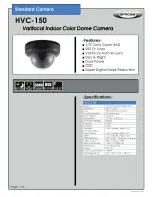
4
4. If necessary, open the sensor enclosure front cover and reconnect the signal wires. Connect
Red to Red and Black to Black on the terminal strip inside the sensor enclosure. Replace
enclosure front cover and be sure to check that the gasket is evenly sealed around the
enclosure. Also tighten the liquid tight fi tting.
5. If necessary, connect the signal wire to the appropriate terminals. Refer to Table 1 and Figure 4
so that you can connect the sensor to the right channel. The black wire will connect to AI1 or
AI2 and the red wire will connect to V+ depending on the required channel number.
6. Connect GA-180 main power, allow sensor to stabilize.
7.
Confi gure the sensor channel. See section II.C.
8. Perform a bump test on all sensors installed on the monitor. Confi rm sensor has appropriate
response to the test gas.
FIGURE 2
C. Battery Backup Installation
1. Disconnect A/C power before beginning this procedure.
2. Insert the battery into the enclosure by removing the surface protection tape and placing the
Velcro strips on the enclosure back plate. The battery should be installed so that the leads are
facing up.
3. Identify the positive (+) and negative (-) leads on the battery. Remove the plastic protectors
on the battery leads and connect the positive lead of the battery to the “BAT +” terminal on the
battery backup board (MB101). Connect the negative lead of the battery to the “BAT –” terminal
on the battery backup board (MB101).
4. Ensure that the appropriate 24 VDC from the power supply is connected to the appropriate PS +
and PS- terminal. For units with battery backup, the DC power must go into these terminals for
proper operation and detection of A/C power failure.
5. If necessary, enable battery backup on relevant sensor channels. Use the screen tree (Figure 11)
to access the relevant screens. Cycle the power to save the enabled battery backup setting.
Note: Battery 1 will need to be enabled to back up sensors 1-4, Battery 2 will need to be enabled
to back up sensors 5-8, Battery 3 will need to be enabled to back up sensors 9-12, and Battery 4
will need to be enabled to backup sensors 13-16. For example, if a system is ordered with 8
sensors then two batteries will need to be installed (into their respective enclosures). Battery 1
and Battery 2 will need to be enabled. If a unit was purchased at the factory to have battery
backup this will have already been done.
Remove calibration cap
at sensor start-up.
Calibration
Cap
Bottom
Front
Sensor Enclosure





































